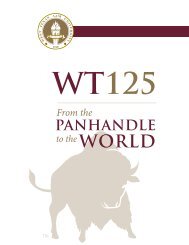The Economic Value of WTAMU Main Report
This report assesses the impact of West Texas A&M University (WTAMU) on the regional economy and the benefits generated by the university for students, taxpayers, and society. The results of this study show that WTAMU creates a positive net impact on the regional economy and generates a positive return on investment for students, taxpayers, and society.
This report assesses the impact of West Texas A&M University (WTAMU) on the regional economy and the benefits generated by the university for students, taxpayers, and society. The results of this study show that WTAMU creates a positive net impact on the regional economy and generates a positive return on investment for students, taxpayers, and society.
Create successful ePaper yourself
Turn your PDF publications into a flip-book with our unique Google optimized e-Paper software.
the next four rows under the section labeled multiplier effect. Summing the<br />
initial and multiplier effects, the gross impacts are $98 million in labor income<br />
and $24.4 million in non-labor income. This sums to a total impact <strong>of</strong> $122.4<br />
million in total added income associated with the spending <strong>of</strong> the university<br />
and its employees in the region. This is equivalent to supporting 1,685 jobs.<br />
x<strong>The</strong> $122.4 million in gross impact is <strong>of</strong>ten reported by researchers as the<br />
total impact. We go a step further to arrive at a net impact by applying a<br />
counterfactual scenario, i.e., what would have happened if a given event – in<br />
this case, the expenditure <strong>of</strong> in-region funds on <strong>WTAMU</strong> – had not occurred.<br />
<strong>WTAMU</strong> received an estimated 36% <strong>of</strong> its funding from sources within the<br />
Texas Panhandle. <strong>The</strong>se monies came from the tuition and fees paid by resident<br />
students, from the auxiliary revenue and donations from private sources<br />
located within the region, from state and local taxes, and from the financial aid<br />
issued to students by state and local government. We must account for the<br />
opportunity cost <strong>of</strong> this in-region funding. Had other industries received these<br />
monies rather than <strong>WTAMU</strong>, income impacts would have still been created in<br />
the economy. In economic analysis, impacts that occur under counterfactual<br />
conditions are used to <strong>of</strong>fset the impacts that actually occur in order to derive<br />
the true impact <strong>of</strong> the event under analysis.<br />
We estimate this counterfactual by simulating a scenario<br />
where in-region monies spent on the university are<br />
instead spent on consumer goods and savings. This<br />
simulates the in-region monies being returned to the<br />
taxpayers and being spent by the household sector.<br />
Our approach is to establish the total amount spent by<br />
in-region students and taxpayers on <strong>WTAMU</strong>, map this<br />
to the detailed industries <strong>of</strong> the MR-SAM model using<br />
national household expenditure coefficients, use the<br />
industry RPCs to estimate in-region spending, and run the in-region spending<br />
through the MR-SAM model’s multiplier matrix to derive multiplier effects. <strong>The</strong><br />
results <strong>of</strong> this exercise are shown as negative values in the row labeled less<br />
alternative uses <strong>of</strong> funds in Table 2.2.<br />
<strong>The</strong> total net impact <strong>of</strong> the university’s operations is equal to the gross impact<br />
less the impact <strong>of</strong> the alternative use <strong>of</strong> funds – the opportunity cost <strong>of</strong> the<br />
regional money. As shown in the last row <strong>of</strong> Table 2.2, the total net impact is<br />
approximately $87.4 million in labor income and $13.6 million in non-labor<br />
income. This sums together to $100.9 million in total added income and is<br />
equivalent to supporting 1,402 jobs. <strong>The</strong>se impacts represent new economic<br />
activity created in the regional economy solely attributable to the operations<br />
<strong>of</strong> <strong>WTAMU</strong>.<br />
<strong>The</strong> total net impact <strong>of</strong> the university’s<br />
operations is $100.9 million in total<br />
added income, which is equivalent to<br />
supporting 1,402 jobs.<br />
Chapter 2: <strong>Economic</strong> Impacts on the Texas Panhandle Economy 25





